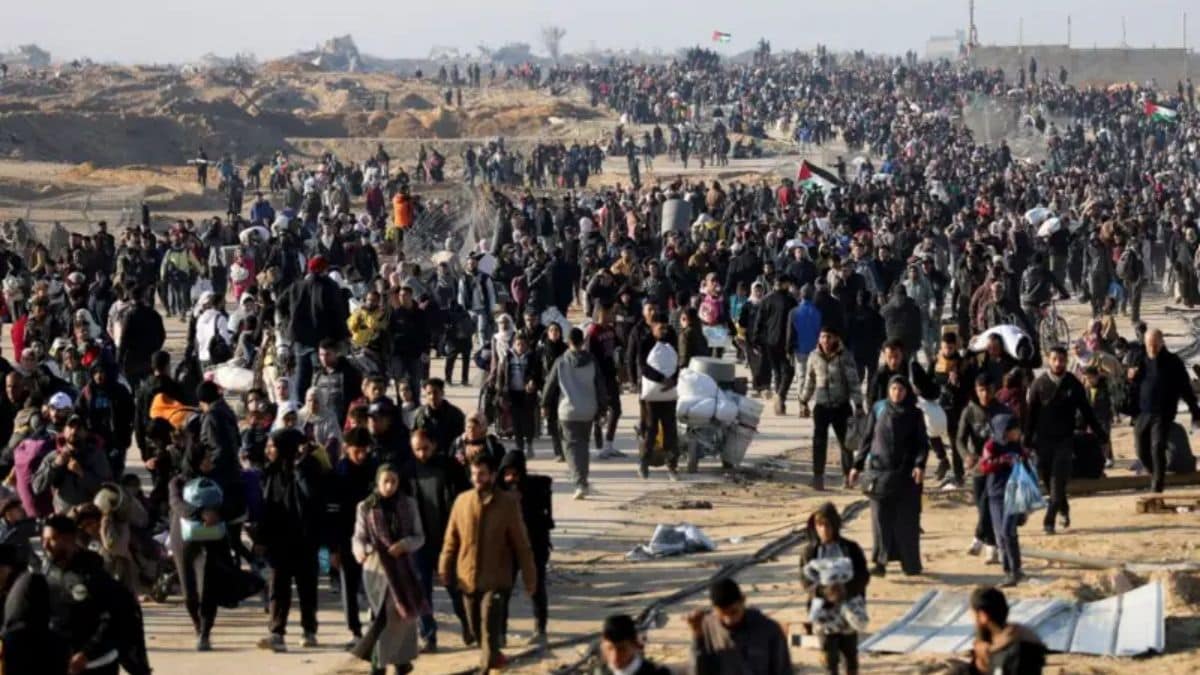Nearly 200,000 Palestinians have arrived in northern Gaza but many of them are finding destroyed homes and ruined neighbourhoods from the yearlong warread more
After nearly 14 months of war, displaced Palestinians have started arriving in northern Gaza from where they had fled earlier in the war.
Even as they have started returning to their homes, many Palestinians are finding houses flattened from Israeli bombardment and fighting on the ground between Israeli forces and Hamas. The United Nations (UN) has said that the vast majority of houses in Gaza have been damaged in the war.
Initially, the return of Palestinians to north appeared uncertain as Israel said that Hamas had reneged on the pledge to release a woman civilian hostage, Arbel Yehud, in the first two batches of hostages released over the past two weeks. After tense negotiations over the weekend, Hamas committed to released Yehud later this week along with other hostages and Israel permitted Palestinians to go northward.
Out of the pre-war population of around 2.1 million, nearly 1.9 million Palestinians were forced to shelter in the southern parts of the enclave as fighting raged in the north. They have now started returning to their homes as per the terms of the ceasefire agreement between Israel and Hamas. Visuals from Gaza show several thousands of people returning both in vehicles and on foot. Many are travelling with carts and makeshift trolleys or strollers to carry their belongings or children.
The AFP reported an official as saying that around 200,000 Palestinians had already returned to northern Gaza.
Palestinians return to north Gaza after breakthrough in hostage diplomacy.
The breakthrough preserves a fragile ceasefire in the Israel-Hamas war, which has devastated the Gaza Strip and displaced nearly all its residentshttps://t.co/p3z8uqX9ao pic.twitter.com/nNFj7yQBLM
— AFP News Agency (@AFP) January 27, 2025
To enter northern Gaza, Palestinians have to cross the Netzarim Corridor, an enclave that Israel has carved out in central Gaza that cuts Gaza into two northern and southern halves.
At the Netzarim Corridor, Egyptian and US private contractors are screening Palestinians for weapons at the Netzarim Corridor and Israeli soldiers are observing the checks from distant with no direct role, according to BBC News.
The Philadelphi Corridor along the Egypt-Gaza border and Netzarim Corridor inside Gaza Strip that Israel reportedly plans to control. (Photo: Reuters)
The security checks are being conducted to address Israel’s security concerns that terrorists or weapons don’t enter Gaza in the midst of civilians.
Palestinians return to ruins in northern Gaza
Palestinians arriving in their neighbourhoods in northern Gaza told BBC that “some areas resemble places hit powerful earthquakes”.
Mohammed Imad Al-Din, a barber, said he found his house completely burned down and his beauty salon looted and damaged in an airstrike on a nearby building. Another person, Lubna Nassar, who along with her three children had been separated from her husband in northern Gaza, discovered her husband was living in a tent after their home was destroyed in the war.
“The warmth of reunion was overshadowed by the bitter reality. We no longer have a home so we moved from a tent in the south to a tent in the north,” said Nassar.
Khaled Raba, 55, said that her relatives told her to not return at all as there was nothing to get back to.
“We were planning to move but my relatives who are still in Jabalia called me and said they don’t advise me to come back. My brother called and said not to come. The houses are demolished to the ground. People are sleeping on the streets and nobody is helping them,” said Raba.
Displaced Palestinians returning to the war-devastated Jabaliya in the Gaza Strip. AFP
The UN has said that 92 per cent of houses in the Gaza Strip have been destroyed or damaged.
Out of total 436,000 housing units affected by the war, 160,000 have been completely destroyed and 276,000 have been damaged partially, according to UN.
Hamas is back
Even as Israel vowed to remove Hamas, the Palestinian terrorist group that has controlled Gaza since 2007, from power in the strip, it appears to have returned to the role it had been deprived of during the war.
The Hamas-run police checkpoints are part of the screening of Palestinians and the terrorist group’s government has started taking up the management of medical and civil services in the strip.
The AFP reported the Hamas-run government has employed “more than 5,500” people to “facilitate the return of displaced people” to Gaza City and the north.
The government has estimated that people in Gaza City and the north need 135,000 tents and caravans as they return to destroyed homes, according to the news agency.
Separately, The New York Times reported the Hamas-run Gazan health ministry as saying that it had set up 19 emergency medical points along the route that Palestinians were taking to go to their homes in northern Gaza. The ministry said these medical points were set up “to provide urgent health care to citizens returning to their areas”.
